Biometrics is by far the most convenient and secure identification technology. It does not require any documents to be carried with you. Remembering any password is a convenient, fast and reliable method of identification. Biometric identification is a technique for identifying an individual's identity through the physiological or behavioral characteristics inherent in the human body. Common biometrics include fingerprints, palm prints, irises, retinas, face shapes, sounds, handwriting, DNA.
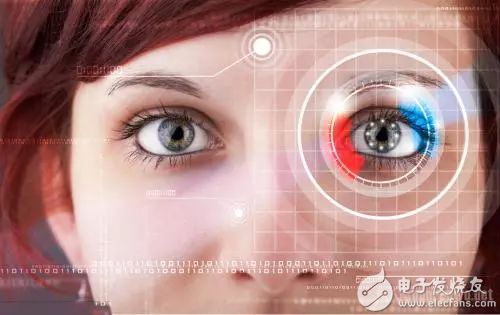
Iris recognition technology is a familiar and unfamiliar, sci-fi mysterious and relatively common perceptual recognition technology. We often see it in science fiction works, and even meet it in daily life. Iris recognition technology claims to be The most accurate and most non-pseudo-perceptual recognition technology adds to its mystery.
What is an iris?
The appearance of the human eye consists of three parts: the sclera, the iris, and the pupil. The sclera is the white part of the periphery of the eyeball. The center of the eye is the pupil part. The iris is located between the sclera and the pupil, and contains the most abundant texture information. Appearance, the iris is composed of many glandular fossa, wrinkles, pigment spots, etc. It is one of the most unique structures in the human body.
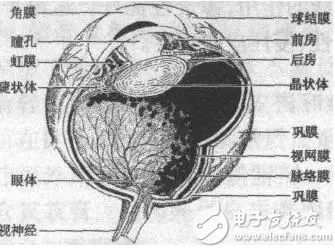
A globular, colored film between the cornea of ​​the vertebrate eye and the lens. It is a part of the vascular membrane and the center is a pupil. The iris is covered with an endothelium in front; the middle layer is loose connective tissue rich in blood vessels and pigment cells. The color of the pigment can make the iris appear different colors. When there is no pigment, it is blue. When the pigment is from as little as possible, the iris can appear gray, brown and brownish black. The iris is lined with two pigment epithelium, and the inner layer of the epithelium differentiates into smooth muscle. The muscle fibers are arranged radially from the inside to the outside, called the pupil opening muscle, the sympathetic innervation, and the sputum hole enlargement; the pupil sphincter is arranged in a ring shape around the pupillary margin. Under the dominance of parasympathetic nerves, the sputum pores shrink.
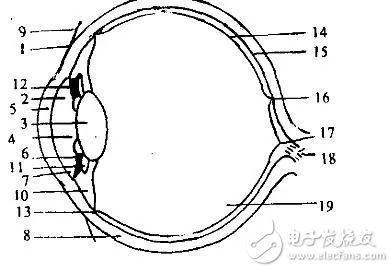
1. limbus 2. anterior chamber 3. lens 4. pupil 5. cornea 6. iris 7. anterior chamber angle 8. sclera 9. bulbar conjunctiva 10. ciliary body 11. posterior chamber 12. lens suspensory ligament 13. Edge 14. Retina 15. Choroid 16. Macular 17. Optic nerve nipple 18. Optic nerve 19. Vitreous
Characteristics of the iris
Uniqueness
The information contained in each iris is different, and the likelihood of identically identical iris tissue is much lower than in other tissues. The iris phase characteristics proposed by Professor John Daugman of the University of Cambridge in the United Kingdom confirmed that the iris image has 244 independent degrees of freedom, ie the average amount of information per square millimeter is 3.2 bits. The fibrous tissue structure of the iris is complex and rich, and its formation is related to the local physical and chemical conditions of the tissue during the embryogenesis stage. It has great randomness and cannot replicate an iris even with cloning technology. Identical twins have different iris texture information, and the iris texture of the same person's left and right eyes does not agree with each other. Test results from the National Physical Laboratory of the United Kingdom indicate that iris recognition is the lowest error rate among various biometric methods.
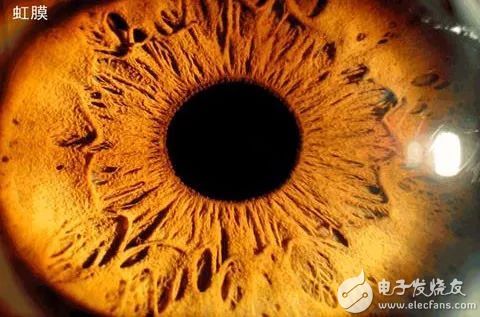
stability
The iris develops from the third month of the baby's embryonic period, and the main texture of the iris has been formed by the eighth month. Unless you experience surgery that is endangering your eyes, it will remain unchanged for the rest of your life. Due to the protective effect of the cornea, the fully developed iris is not vulnerable to external damage.
Anti-counterfeiting
The iris is the visible part of the human eye, under the protection of the sclera, and has a strong biological activity. For example, the size of the pupil changes with the intensity of the light; there is an unconscious adjustment process when viewing the object; there is an unconscious pupil scaling of up to ten times per second; when the human brain is dead, in a deep coma or when the eye tissue is detached from the human body, the iris The tissue is completely contracted and there is a dilated phenomenon. These biological activities and human life phenomena exist at the same time, and symbiosis, so it is impossible to replace the iris image of the living with photos, videos, and corpses of irises, thus ensuring the authenticity of physiological tissues.
non contact
The iris is an externally visible internal organ that can obtain a qualified iris image without being attached to the collection device. The recognition method is more clean and hygienic than the biometric features such as fingerprints and hand shapes that need to be touched, and will not deface the imaging device and affect others. Identification.
Easy signal processing
The area adjacent to the iris in the eye image is the pupil and sclera, and there are significant gray scale changes in the iris area, and the area boundaries are close to a circle, so the iris area is easy to fit the segmentation and normalization. The iris structure facilitates a mode representation with translational, scaling, and rotational invariance.
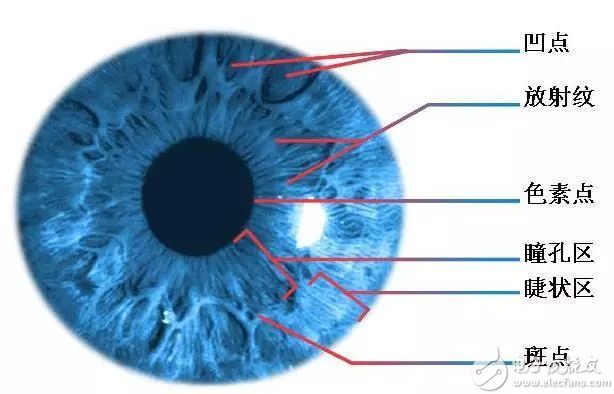
Uniqueness, stability, and anti-counterfeiting, all of which are unmatched by other two-dimensional codes, RFID and other perceptual recognition technologies. The iris is the only internal tissue that can be directly observed from the outside, and contains a wealth of information. Identification has become a very important, perceptual recognition technology that is especially suitable for environments with high confidentiality requirements.
The origin of iris recognition technology
In 1885, ALPHONSEBERTILLON applied the idea of ​​biometric identification to the criminal prison in Paris. The biometrics used at that time included the size of the ear, the length of the foot, and the iris.
In 1987, ophthalmologists ARAN SAFIR and LEONARDFLOM first proposed the concept of automatic iris recognition using iris images. By 1991, JOHNSON of the Los Alamos National Laboratory in the United States realized an automatic iris recognition system.
In 1993, JOHNDAUGMAN implemented a high-performance automatic iris recognition prototype system. Today, most automatic iris recognition systems use the DAUGMAN core algorithm.
The country has not had its own core intellectual property rights in the identification of iris before 2000. Based on years of research by the Chinese Academy of Sciences, the core algorithm of iris recognition was developed in early 2000, and it has become one of the few core algorithms in the world that has mastered iris recognition. One of the units.
The principle of iris recognition technology
Iris recognition determines the identity of people by comparing the similarities between iris image features. The core is to describe and match the iris features of human eyes using pattern recognition, image processing, etc., to achieve automatic personal identity authentication. The main steps of iris recognition include acquisition of iris images, preprocessing, feature extraction and coding, and classification.
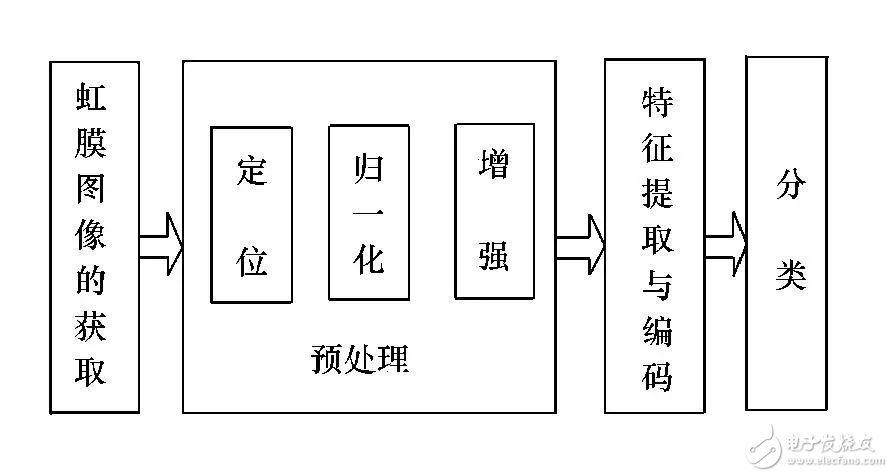
Iris image acquisition
Iris image acquisition refers to the use of a specific digital camera device to capture the entire eye of a person, and the captured image is transmitted to a computer through an image capture card for storage. The acquisition of iris images is the first step in iris recognition, and it is also a difficult step, requiring a comprehensive application of light, machine and electricity technology. Because the area of ​​people's eyes is small, if the image resolution requirement of the recognition algorithm is required, the magnification of the optical system must be increased, resulting in a small depth of field for iris imaging, so the existing iris recognition system requires the user to stop at a suitable position. Eye and Stare. In addition, the iris of the Orientals is darker in color, and an identifiable iris image cannot be acquired with a normal camera. Different from the image acquisition of biological features such as face and gait, the acquisition of iris image requires a reasonable optical system and the necessary light source and electronic control unit.
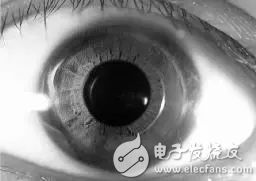
Due to the high technical threshold of the iris image acquisition device, the research on iris recognition in China is limited. In 1999, the Institute of Automation of the Chinese Academy of Sciences developed the first set of iris image acquisition systems with independent intellectual property rights in China, which is characterized by compactness, flexibility, low cost and clear images. After continuous updating, the newly developed iris imager of the Automation Institute has been able to collect qualified iris images through voice prompts and active visual feedback in the range of 20-30 cm.
Image preprocessing
Image pre-processing refers to pre-processing operations including image smoothing, edge detection, image separation, etc., because the captured eye image includes a lot of redundant information and cannot meet the requirements in terms of sharpness and the like.
The iris image preprocessing process usually includes three parts: iris positioning, iris image normalization, and image enhancement.
Iris positioning
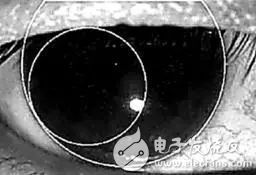
It is generally believed that the inner and outer boundaries of the iris can be approximated by a circle. The inner circle represents the boundary between the iris and the pupil, and the outer circle represents the boundary between the iris and the sclera, but the two circles are not concentric. Usually, the part of the iris close to the upper and lower eyelids is always blocked by the eyelids, so the boundary between the iris and the upper and lower eyelids must also be detected to accurately determine the effective area of ​​the iris. The boundary between the iris and the upper and lower eyelids can be represented by a quadratic curve. The purpose of iris positioning is to determine the position of these circles and the quadratic curve in the image. Commonly used positioning methods are roughly divided into two categories, one is the combination of edge detection and Hough transform; the other is the method based on edge search. The common shortcoming of these two methods is that the operation time is long, so some improved methods based on the above two strategies have emerged, but the speed has not increased by an order of magnitude. Positioning is still one of the longest steps in the iris recognition process.
Iris image normalization

The purpose of iris image normalization is to adjust the size of the iris to a fixed size. So far, accurate mathematical models of iris texture with illumination have not been obtained. Therefore, researchers engaged in iris recognition mainly use the mapping method to normalize the iris image. If you can establish a mathematical model or approximate the process of the iris texture with the change of light intensity, it will greatly improve the performance of the iris recognition system.
Image enhancement
The purpose of image enhancement is to solve the problem of low contrast of the image after normalization due to uneven illumination of the human eye image. In order to improve the recognition rate, it is necessary to perform image enhancement on the normalized image.
Feature extraction
Feature extraction refers to the extraction of unique feature points from the separated iris images by a certain algorithm and encoding them.
The mainstream iris feature extraction and recognition methods can be divided into eight categories.
First, based on the image method, the iris image is regarded as a two-dimensional quantity field, and the pixel gray values ​​constitute a joint distribution, and the correlation between the image matrices measures the similarity.
Second, based on the phase-based method, this method considers that important details in the image, such as the position information of "events" such as points, lines, edges, etc., are mostly contained in the phase, so the reflection of the light intensity and contrast is discarded during feature extraction. Amplitude information.
Third, based on the singular point method, the singular points in the iris image are divided into two types, zero crossings and extreme points.
Fourth, based on the method of multi-channel texture filtering statistical features, the iris image can be regarded as a two-dimensional texture, and there are distinguishing statistical features in different scales and directions in the frequency domain for identification, which is also in texture analysis. Commonly used methods.
Fifthly, based on the method of frequency domain decomposition coefficient, the image can be regarded as composed of many different frequencies and directions. By analyzing the size distribution of the image at each base, the image can have a deep understanding of the regular information in the image.
Sixth, based on the shape characteristics of the iris signal, the iris signal shape feature includes two aspects of information, two-dimensional shape information of the undulating and convex surface of the iris surface, and one-dimensional shape information along the circumference of the iris.
Seventh, based on the directional feature method, Direction or Orientation is a relative value, which is more robust to illumination and contrast changes, and can describe local grayscale features. It is a suitable iris image. The form of feature expression.
Eighth, based on the subspace method, the subspace method needs to find several optimal bases on the larger scale training data set according to the defined optimal criteria, and then use the projection coefficient of the original image on the optimal basis as the drop. Dimensional image features.
Feature matching
Feature matching means that the feature code obtained by feature extraction based on the currently acquired iris image is compared and verified with the iris image feature code stored in the database in advance, thereby achieving the purpose of recognition.
The main system of iris recognition technology
At present, the most influential iris recognition systems are Daugman system, Wildes system, Boles system and Chinese Academy of Sciences iris system.
Daugman system
At present, many iris recognition products in the world use the iris recognition algorithm proposed by Dr. Daugman of the University of Cambridge, England. In the algorithm, the integral differential operator (Integro-differential operator) is used to detect the inner and outer circular boundaries of the iris:
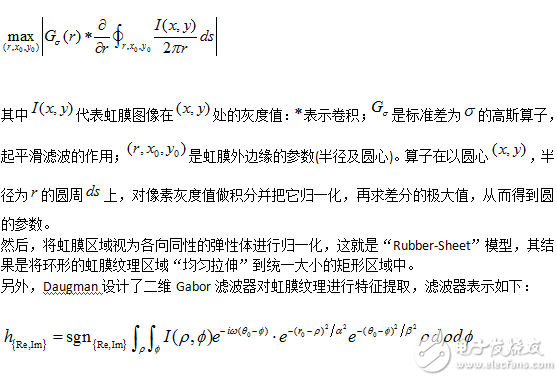
After filtering, the phase information is extracted, and the obtained phase information is quantized into a binary iris code, which is 2048 bits in total. The normalized Hamming distance between binary codes obtained from the two iris images is used as a similar shape metric to compare and identify the iris.
In addition, this system also uses a relatively simple and intuitive method to solve the problem of the rotation of the iris texture. The rotation of the original iris texture corresponds to the normalized left and right translation, so Daugman uses the number of digits of the iris code to translate left and right and then compares them separately to find the smallest Hamming distance as the similarity between the two irises. measure.
Wildes system
The Wildes system is compared to the Daugman system and uses a different identification process. First, the detection of the inner and outer circles of the iris is performed using the extended Hough transform. In the problem of overcoming the translation, scaling and rotation of the iris, the image registration method was adopted without normalizing it into a uniform rectangular area.
Wildes believes that only 2048-bit encoding is used to indicate that the texture features of the iris may contain too little information, so the amount of data in the system is large. He proposes to use an isotropic Gaussian-Laplace filter:

After filtering the image at different resolutions, 1/2 sampling is performed successively, and data of different scales is obtained to form a 4-layer pyramid structure, and these data are used as features of iris recognition. Finally, use the Fisher classifier for classification.
Boles system
Boles uses the integral mean of the wavelet transform between the zero-crossing of the wavelet transform and the two successive zero-crossings to represent the iris feature. Before encoding the iris texture image, the iris image is sampled along a concentric circle centered on the center of the iris, and the two-dimensional iris image is transformed into a one-dimensional signal, which is then transformed by a specific wavelet function. Here the "specific" wavelet function is defined as the second derivative of a smooth function, ie the wavelet function is defined as:
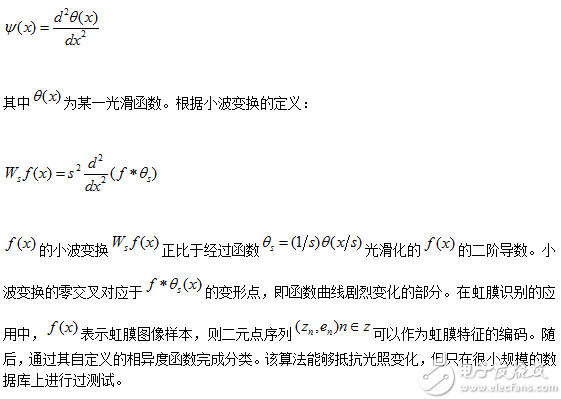
Chinese Academy of Sciences iris system
In their system, Ma Li and Tan Tieniu of the Chinese Academy of Sciences not only proposed the use of Fourier transform to evaluate the quality of iris images, but also improved the modulation function of Gabor filters based on Daugman's feature extraction using Gabor filters. Make it have a circular symmetry, the expression is as follows:

The filtered image is then partitioned, and the mean and variance of each block are extracted to form the feature vector of the iris. Finally, the Fisher linear rule is used to reduce the dimension of the feature vector, and the feature matching is performed according to the nearest neighbor classifier. Compared with the other two classical methods, Daugman and Boles, this method can also achieve better recognition results.
Application field of iris recognition technology
Power / nuclear power plant / military field
In order to improve the network, intelligence and informationization of power stations, improve management efficiency and safety, the current international advanced iris recognition technology, combined with computer network in data acquisition, data communication, data retrieval, system control and other advantages, to achieve Access control of the main passage (entry and exit), personnel attendance management of the staff. According to the status quo of the substation equipment, it can be transformed into an anti-missing locking system with iris identity authentication, which greatly improves the safety of operation.
Industrial and mining / enterprise sector
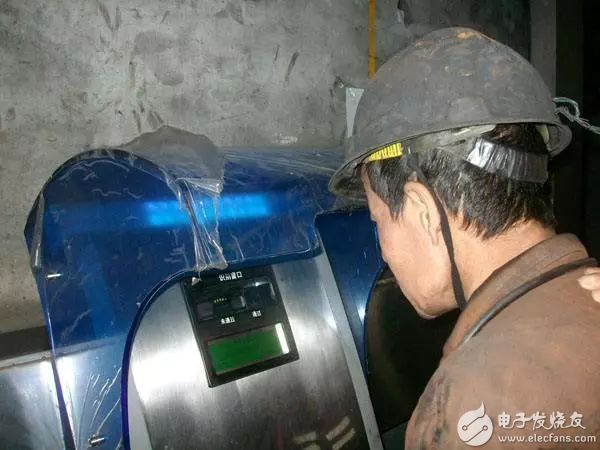
Mine iris attendance system is an important part of coal mine safety production management. It can enable enterprise managers to understand the underground production status and personnel composition in a timely manner, effectively improve safety production management and labor organization, and is an important means to improve safety production efficiency. Commonly used in the market are magnetic card, IC card, RF card and other technology to achieve the attendance machine, it can not solve the alternative problem, and biometric identification technology such as fingerprints, because the recognition accuracy is not enough, can not adapt to the harsh environment of the underground, equipment maintenance difficulties and other issues Can not meet the needs. The iris recognition attendance system can fundamentally eliminate the substitution phenomenon during attendance. Its high security, rapid identification and its unique ease of use in the mine are incomparable to other biometric systems.
Prison / Detention Center / Counter-Terrorism / Public Security
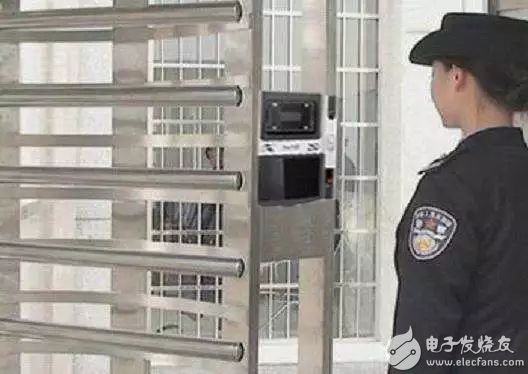
Prison: Buffer access control: Iris certification is carried out on the place where the entry is prohibited.
Management of mobile personnel: iris collection is performed for the inspectors, and iris recognition is performed after the inspection is completed to determine whether the in and out are the same person.
Public security criminal investigation: accurately identify criminal suspects; quickly confirm the identity of criminals; verify the identity of death penalty prisoners.
Public security exit and entry management: ID card / passport: ID can be identified through the iris.
Road patrol system: check suspicious personnel
Anti-terrorism: You can capture iris information and compare it with anti-terrorist information.
New Rural Cooperative/Urban and Rural Residents Pension/Medical/CDC/Illegal Drug/Virus Laboratory
After the social security socialization, the insured personnel flowed and dispersed due to reasons such as the relocation, change, and closure of the unit. Therefore, determining the survival status of policyholders has always been a problem in social security payment claims. The only way to solve this problem is to use biometric technology for identity identification.
There are many biometric technologies that can be used, such as fingerprints, palm prints, voice prints, irises, face, ear type, body odor, DNA (human cell genetics), and the like. Biological characteristics are objective and unique. People are different, life-changing, and have the characteristics of being imitation.
Compared with various biometric technologies, from the perspective of technology maturity and ease of use, the current iris automatic recognition technology is especially suitable for the use of social security systems, and it is also the safest and most accurate biotechnology.
New Rural Cooperative Medical: Iris collection is carried out when applying for the new rural cooperative medical system, and then each time the iris is verified, the relevant business can only be handled after verification.
Finance / Banking / Taxation
With the continuous development of the financial industry, the competition in the financial market is intensifying, the management of banks is becoming more standardized, and the security issue has become a top priority. The application of iris recognition products in the banking industry is the general trend.
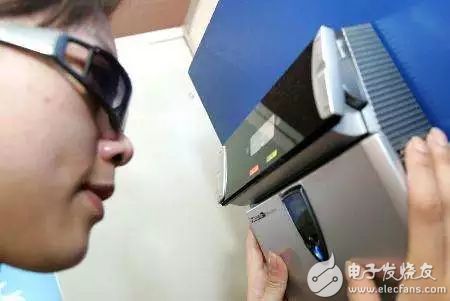
Bank vault access: You can save the iris information of the person who has access to the vault, and perform iris verification every time you enter the vault. Multi-person verification and off-site verification can also be set up to strengthen the security management of the bank vault.
Management of the cash-carrying vehicle: collect and save the iris information of the personnel involved in the cash-carrying vehicle, perform iris verification at the time of attendance, and also set the authority to open the cash box. Only the authorized personnel can open the cash box, effectively ensuring the funds. safety.
The identity verification of the credit officer: the person who borrows each time will perform iris verification first. If there is iris information of the person, it means that the person has borrowed money and can stop issuing the loan; if there is no iris information of the person, save it to prevent Once again, borrowing effectively eliminated the loss of funds.
Civil Aviation / Airport / Customs / Port Area
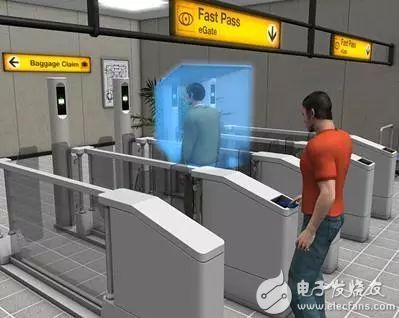
The iris recognition system has been playing an increasingly important role in many fields at home and abroad, such as the automatic identification and customs clearance system at the airport and seaport customs, the detection system and the identity detection mobile device used by the police. The iris identification system can apply different permissions to the certified personnel in the required key areas, channels, and ports. For those unauthenticated personnel who try to force them through, the system will automatically take measures to close them in the alert space. Automatic quick clearance is a typical application of iris recognition. Its application not only raises the security level of the airport, relieves the pressure of people, but also brings economic benefits to the airport. Today, when public safety becomes a hot issue, the application of iris recognition technology at domestic airports will certainly become a development trend as internationally.
Motor Control And Protection Management System
As a leader in engineering and industrial software, Elecnova electric helps to build sustainable motor protection solutions across the electrical system and the industrial processes by providing a robust, tested and validated architectural approach to your motor management.
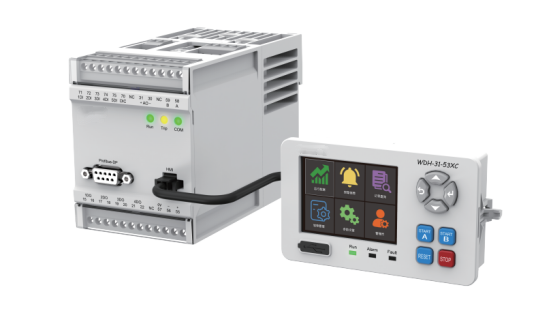
Motor Control And Protection Management System,Integrated Motor Control System,Motor Control Device Basic Protection,Motor Protection Controller Temperature Monitoring
Jiangsu Sfere Electric Co., Ltd , https://www.elecnova-global.com
